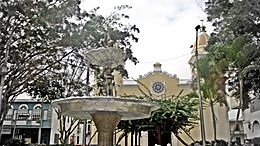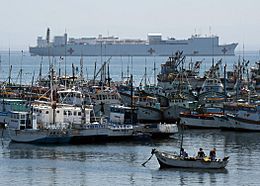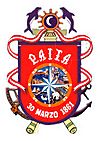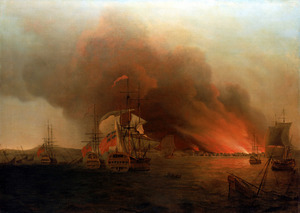Paita facts for kids
Quick facts for kids
Paita
|
|||
|---|---|---|---|
|
City
|
|||
|
|||
| Country | |||
| Region | Piura | ||
| Province | Paita | ||
| District | Paita | ||
| Established | 1782 | ||
| Area | |||
| • Total | 1,768.65 km2 (682.88 sq mi) | ||
| Elevation | 350 m (1,150 ft) | ||
| Population
(2016)
|
|||
| • Total | 179,346 | ||
| • Estimate
(2015)
|
168 900 | ||
| Demonym(s) | Paiteño (a) | ||
| Time zone | UTC-5 (PET) | ||
| • Summer (DST) | UTC-5 (PET) | ||
Paita is an important city and port in northwestern Peru. It is the capital of the Paita Province, which is part of the Piura Region. Paita is a major seaport in the area. It is located about 1,089 km northwest of Lima, Peru's capital city. It is also 57 km northwest of Piura, the capital of the Piura Region. Since 2014, some people in Paita have thought about making their area a separate region. They want to call it the "Miguel Grau Region."
Contents
Geography of Paita
Paita is located at 05°05′28″S 81°06′23″W / 5.09111°S 81.10639°W. It sits on a small piece of land that sticks out into the ocean. This land is south of where the Río Chira meets the sea. The city covers an area of about 1,785 km2. Paita faces the Bay of Paita, which is a natural harbor. A headland called Punta Paita and a large hill called Silla de Paita protect the bay from strong southerly winds. The city of Piura, the capital of the Piura Region, is 90 km to the southeast. Chiclayo, a big commercial city in the Lambayeque region, is 160 km to the south.
Population Growth
The number of people living in Paita has grown a lot over the years. In 1906, there were about 3,800 people. By 1993, the population had grown to 20,000. In 2007, it reached 122,127, and by 2015, it was estimated to be 168,900.
History of Paita
Early Human Settlements
In 1978, a scientist named Edgar Herning found old remains in Paita. His discoveries showed that people lived here a very long time ago. There is proof of early villages on the coast of Paita, like Colan, Tayta, and Amotape. These villages existed up to 9,000 years ago. This suggests that the people living here were a highly developed cultural group.
Colonial Times
The city of Paita was officially started on March 30, 1532. This was done by the Spanish conqueror Francisco Pizarro. He named it San Francisco de Paita of Good Hope.
From 1578 to 1588, Paita was the main Spanish city on the northwestern coast of Peru. However, attacks from English pirates and corsairs (private ships allowed to attack enemy ships) made it unsafe. Because of these attacks, the capital had to be moved to Piura. Paita was also an important port for Peru. It was the final stop for the Manila Galleons, which were Spanish ships that connected Latin America with Asia.
Many Peruvians know the port of Paita as the place where Manuela Sáenz used to live. She was a famous figure known for her relationship with Simón Bolívar, a hero who helped many South American countries gain independence.
Paita as a Whaling Port
Paita was a very important stop for whaling ships in the early 1800s. Whaling ships from Britain and America often visited Paita. They came to get supplies and make repairs. The whaling areas west of Peru were popular for hunting whales. Sometimes, local men from Paita would join these ships as crew members. The first British whaling ship known to visit was the Emilia in 1792. In 1833 alone, sixty-four American whaling ships stopped here. So many American ships visited that the United States government decided to open a consulate in Paita in 1833. A hospital for American sailors was also built in the 1840s.
The large, protected Bay of Paita offered a safe place for ships to anchor. Farms in the nearby Chira Valley grew many different crops. These crops were sold to the whalers. The money spent by the whalers helped the local economy a lot. This continued until American whaling visits started to decrease in the 1860s.
Industry and Trade
In 1875, a railway line was finished. It was 97 km long and connected Piura to Paita. However, this railway was destroyed during the War of the Pacific with Chile from 1879 to 1883. It was rebuilt in 1884. A street railway also opened in Paita on August 30, 1891, and it ran until the late 1920s.
Today, the port of Paita is Peru's fifth-largest port. It is a very important port for shipping containers. Its location on the Pacific coast is strategically important for trade. Paita has one of the best natural harbors along the Peruvian coast. Regular mail steamers (ships that carry mail and passengers) travel between Valparaíso in Chile and Panama.
Local Celebrations
On September 24, Paita celebrates the Fiesta de Nuestra Señora de las Mercedes. This celebration lasts for a week. It includes special trips and events to honor a Catholic religious figure.
Sister Cities Around the World
Paita has "sister city" relationships with many cities around the world. These connections help promote cultural and economic ties.
 Panama City, Panama
Panama City, Panama Balboa, Panama
Balboa, Panama Munich, Germany
Munich, Germany Callao, Peru
Callao, Peru Tokyo, Japan
Tokyo, Japan Lima, Peru
Lima, Peru Beijing, China
Beijing, China Riga, Latvia
Riga, Latvia Barcelona, Spain
Barcelona, Spain New York, United States
New York, United States Manta, Ecuador
Manta, Ecuador Guayaquil (Guayas), Ecuador
Guayaquil (Guayas), Ecuador Quito (Pichincha), Ecuador
Quito (Pichincha), Ecuador Mexico City, Mexico
Mexico City, Mexico Caracas, Venezuela
Caracas, Venezuela
Famous People from Paita
Many notable people have come from Paita:
- Miguel Grau: He is a national hero of Peru. He is known as one of Peru's most important sailors.
- Luigi Alva: A famous light tenor singer.
- Luciano Castillo Colonna: A Peruvian politician, university professor, and lawyer. He founded the Socialist Party of Peru in 1930.
- Pilar Pallete: A Hollywood actress. She was married to the famous actor John Wayne.
- Antonio de la Haza: A sailor and hero during the Peruvian-Ecuadorian War (1858-1860).
- Camilo Carrillo: A politician, mathematician, and sailor. He took part in the Pacific War and the Combat of Dos de Mayo.
Images for kids
See also
 In Spanish: Paita para niños
In Spanish: Paita para niños













